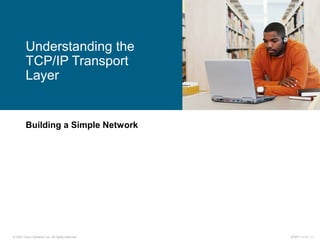More Related Content Similar to CCNA Icnd110 s01l05 Similar to CCNA Icnd110 s01l05 (20) More from computerlenguyen More from computerlenguyen (20) Recently uploaded Industrial Policy - 1948, 1956, 1973, 1977, 1980, 1991 Industrial Policy - 1948, 1956, 1973, 1977, 1980, 1991 RKavithamani
1. © 2007 Cisco Systems, Inc. All rights reserved. ICND1 v1.0—1-1
Building a Simple Network
Understanding the
TCP/IP Transport
Layer
2. © 2007 Cisco Systems, Inc. All rights reserved. ICND1 v1.0—1-2
Transport Layer
Session multiplexing
Segmentation
Flow control (when required)
Connection-oriented
(when required)
Reliability (when required)
3. © 2007 Cisco Systems, Inc. All rights reserved. ICND1 v1.0—1-3
Reliable vs. Best-Effort Comparison
4. © 2007 Cisco Systems, Inc. All rights reserved. ICND1 v1.0—1-4
Operates at transport layer of OSI and TCP/IP models
Provides applications with access to the network layer without the
overhead of reliability mechanisms
Is a connectionless protocol
Provides limited error checking
Provides best-effort delivery
Has no data-recovery features
UDP Characteristics
5. © 2007 Cisco Systems, Inc. All rights reserved. ICND1 v1.0—1-5
UDP Header
6. © 2007 Cisco Systems, Inc. All rights reserved. ICND1 v1.0—1-6
TCP Characteristics
Transport layer of the TCP/IP stack
Access to the network layer for applications
Connection-oriented protocol
Full-duplex mode operation
Error checking
Sequencing of data packets
Acknowledgement of receipt
Data-recovery features
7. © 2007 Cisco Systems, Inc. All rights reserved. ICND1 v1.0—1-7
TCP Header
8. © 2007 Cisco Systems, Inc. All rights reserved. ICND1 v1.0—1-8
File transfer
– FTP
– TFTP
– Network File System
E-mail
– Simple Mail Transfer Protocol
Remote login
– Telnet
– rlogin
Network management
– Simple Network Management
Protocol
Name management
– Domain Name System
TCP/IP Application Layer Overview
9. © 2007 Cisco Systems, Inc. All rights reserved. ICND1 v1.0—1-9
Mapping Layer 3 to Layer 4
10. © 2007 Cisco Systems, Inc. All rights reserved. ICND1 v1.0—1-10
Mapping Layer 4 to Applications
11. © 2007 Cisco Systems, Inc. All rights reserved. ICND1 v1.0—1-11
Establishing a Connection
12. © 2007 Cisco Systems, Inc. All rights reserved. ICND1 v1.0—1-12
Three-Way Handshake
CTL = Which control bits in the TCP header are set to 1
13. © 2007 Cisco Systems, Inc. All rights reserved. ICND1 v1.0—1-13
Flow Control
14. © 2007 Cisco Systems, Inc. All rights reserved. ICND1 v1.0—1-14
TCP Acknowledgment
15. © 2007 Cisco Systems, Inc. All rights reserved. ICND1 v1.0—1-15
Fixed Windowing
16. © 2007 Cisco Systems, Inc. All rights reserved. ICND1 v1.0—1-16
TCP Sliding Windowing
17. © 2007 Cisco Systems, Inc. All rights reserved. ICND1 v1.0—1-17
TCP Sequence and Acknowledgment
Numbers
18. © 2007 Cisco Systems, Inc. All rights reserved. ICND1 v1.0—1-18
Summary
The purpose of the transport layer is to hide the network
requirements from the application layer.
Connection-oriented transport provides reliable transport;
connectionless transport provides best-effort transport.
UDP is a protocol that operates at the transport layer and
provides applications with access to the network layer without the
overhead of the reliability mechanisms of TCP. UDP is a
connectionless, best-effort delivery protocol.
TCP is a protocol that operates at the transport layer and
provides applications with access to the network layer. TCP is
connection-oriented, provides error checking, delivers data
reliably, operates in full-duplex mode, and provides some data
recovery functions.
19. © 2007 Cisco Systems, Inc. All rights reserved. ICND1 v1.0—1-19
Summary (Cont.)
TCP/IP supports a number of applications, including FTP
(supports bidirectional binary and ASCII file transfers), TFTP
(transfers configuration files and Cisco IOS images), and Telnet
(provides capability to remotely access another computer).
IP uses a protocol number in the datagram header to identify
which protocol to use for a particular datagram.
Port numbers are used to map Layer 4 to an application.
20. © 2007 Cisco Systems, Inc. All rights reserved. ICND1 v1.0—1-20
Summary (Cont.)
Flow control avoids the problem of a transmitting host overflowing
the buffers in the receiving host and slowing network
performance.
TCP provides sequencing of segments with a forward reference
acknowledgment. When a single segment is sent, receipt is
acknowledged and the next segment is then sent.
21. © 2007 Cisco Systems, Inc. All rights reserved. ICND1 v1.0—1-21
Summary (Cont.)
The TCP window size decreases the transmission rate to a level
at which congestion and data loss do not occur. The TCP window
size allows a specified number of unacknowledged segments to
be sent.
A fixed window is a window with an unchanging size that can
accommodate a specific flow of segments.
A TCP sliding window is a window that can change size
dynamically to accommodate the flow of segments.
TCP provides the sequencing of segments by providing sequence
numbers and acknowledgment numbers in TCP headers.
22. © 2007 Cisco Systems, Inc. All rights reserved. ICND1 v1.0—1-22
Editor's Notes Lesson Aim
<Enter lesson aim here.>
Lesson Aim
<Enter lesson aim here.>
Lesson Aim
<Enter lesson aim here.>
Purpose: This figure discusses application-layer protocols.
Emphasize: The common network applications today include file transfer, remote login, network management, and e-mail.
We focus on TCP/IP in this course for several reasons:
TCP/IP is a universally available protocol and you will use it at work.
TCP/IP is a useful reference for understanding other protocols, because it includes elements that are representative of other protocols.
TCP/IP is important because the router uses it as a configuration tool. The router uses Telnet for remote configuration, TFTP to transfer configuration files and operating system images, and SNMP for network management.
Transition: The next section moves down the model to discuss the transport layer.
Lesson Aim
<Enter lesson aim here.>
Lesson Aim
<Enter lesson aim here.>
Lesson Aim
<Enter lesson aim here.>
Lesson Aim
<Enter lesson aim here.>
Lesson Aim
<Enter lesson aim here.>
Lesson Aim
<Enter lesson aim here.>
Lesson Aim
<Enter lesson aim here.>
Lesson Aim
<Enter lesson aim here.>
Lesson Aim
<Enter lesson aim here.>
